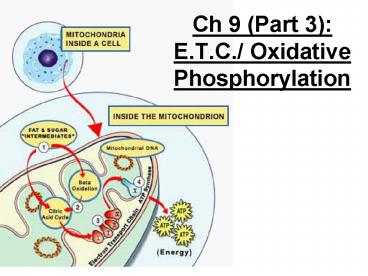Ch 9 Part 3: E'T'C' Oxidative Phosphorylation - PowerPoint PPT Presentation
1 / 27
Title:
Ch 9 Part 3: E'T'C' Oxidative Phosphorylation
Description:
Citric. acid. cycle. H Q. III. I. II. FAD. FADH2 ... Citric. acid. cycle. 2. Acetyl. CoA. 2 NADH. Glycolysis. Glucose. 2. Pyruvate 2 ATP. by substrate-level ... – PowerPoint PPT presentation
Number of Views:199
Avg rating:3.0/5.0
Title: Ch 9 Part 3: E'T'C' Oxidative Phosphorylation
1
Ch 9 (Part 3) E.T.C./ Oxidative Phosphorylation
2
- ? So far, in glycolysis the Krebs cycle, 1
glucose molecule has resulted in - ? 4 ATPs (2 from glycolysis, 2 from Krebs)
- ? 10 NADH (2 from gly., 2 from acetyl-CoA step,
6 from Krebs Cycle) - ? 2 FADH2 (from Krebs Cycle)
x2
3
- ? Following glycolysis and the Krebs cycle, NADH
and FADH2 account for most of the energy
extracted from food - ? These two electron carriers donate electrons to
the electron transport chain, which powers ATP
synthesis via oxidative phosphorylation
4
ELECTRON TRANSPORT CHAIN (E.T.C.)
- ? E.T.C. a collection of molecules (mostly
protein complexes) embedded in the inner membrane
of mitochondrion (foldings of inner membrane form
CRISTAE)
5
(No Transcript)
6
The Pathway of Electron Transport
- ? the groups along the chain alternate between
reduced oxidized states as they accept and
donate electrons - ? each successive group is more electronegative
than the group before it, so the electrons are
pulled downhill towards OXYGEN (the final
electron carrier!)
7
NADH
50
FADH2
Multiprotein complexes
I
FAD
40
FMN
II
FeS
FeS
Q
III
Cyt b
Oxidative phosphorylation electron transport and
chemiosmosis
Citric acid cycle
Glycolysis
FeS
30
Cyt c1
IV
Free energy (G) relative to O2 (kcal/mol)
Cyt c
ATP
ATP
ATP
Cyt a
Cyt a3
20
10
O2
2 H 1/2
0
H2O
8
(No Transcript)
9
- ? as molecular oxygen (O2) is reduced, it also
picks up H from the environment to form water
(H2O)
10
ATP Production of the E.T.C.
- Typically, the ATP produced is as follows
- 1 NADH ? 3 ATP
- 1 FADH2 ? 2 ATP
- (FADH2 is dropped off at a lower point in the
E.T.C., so it generates fewer ATPs)
exchange rate
11
(No Transcript)
12
Chemiosmosis The Energy-Coupling Mechanism
- ? Electron transfer in the electron transport
chain causes proteins to pump H from the
mitochondrial matrix to the intermembrane space
(active transport) - ? H (protons) then move back across the
membrane, passing through channels in ATP synthase
13
Chemiosmosis The Energy-Coupling Mechanism
- ? ATP synthase uses the exergonic flow of H to
drive phosphorylation of ATP - ? This is an example of CHEMIOSMOSIS, the use of
energy in a H gradient to drive cellular work
14
- ? The energy stored in a H gradient across a
membrane couples the redox reactions of the
electron transport chain to ATP synthesis - ? The H gradient is referred to as a
PROTON-MOTIVE FORCE, emphasizing its capacity to
do work
15
(No Transcript)
16
(No Transcript)
17
(No Transcript)
18
(inner matrix)
? protons then diffuse back across the membrane
through the ATP synthase complex which causes
the phosphorylation of ADP to form ATP!
(intermembrane space)
19
(No Transcript)
20
INTERMEMBRANE SPACE
A rotor within the membrane spins as shown when
H flows past it down the H gradient.
H
H
H
H
H
H
H
A stator anchored in the membrane holds the knob
stationary.
A rod (or stalk) extending into the knob also
spins, activating catalytic sites in the knob.
H
Three catalytic sites in the stationary knob join
inorganic phosphate to ADP to make ATP.
ADP
ATP
P
i
MITOCHONDRAL MATRIX
21
Inner mitochondrial membrane
Oxidative phosphorylation electron transport and
chemiosmosis
Citric acid cycle
Glycolysis
ATP
ATP
ATP
H
H
H
H
Cyt c
Protein complex of electron carriers
Intermembrane space
Q
IV
III
I
ATP synthase
II
Inner mitochondrial membrane
H2O
2H 1/2 O2
FADH2
FAD
NAD
H
NADH
ADP
ATP
P
i
(carrying electrons from food)
H
Mitochondrial matrix
Electron transport chain Electron transport and
pumping of protons (H), Which create an H
gradient across the membrane
Chemiosmosis ATP synthesis powered by the flow of
H back across the membrane
Oxidative phosphorylation
22
ELECTRON TRANSPORT CHAIN ANIMATION!
23
SUMMARY
- ? most energy flows in this sequence
- Glucose ? NADH ? E.T.C. ? proton ? ATP
-
motive -
force
24
(No Transcript)
25
(No Transcript)
26
- ? approximately 40 of energy in glucose is
converted to ATP - ? the remaining energy is lost as heat
27
Electron shuttles span membrane
MITOCHONDRION
CYTOSOL
2 NADH
or
2 FADH2
2 FADH2
2 NADH
6 NADH
2 NADH
Oxidative phosphorylation electron
transport and chemiosmosis
Glycolysis
2 Acetyl CoA
Citric acid cycle
2 Pyruvate
Glucose
2 ATP
2 ATP
about 32 or 34 ATP
by substrate-level phosphorylation
by substrate-level phosphorylation
by oxidation phosphorylation, depending on which
shuttle transports electrons form NADH in cytosol
About 36 or 38 ATP
Maximum per glucose































